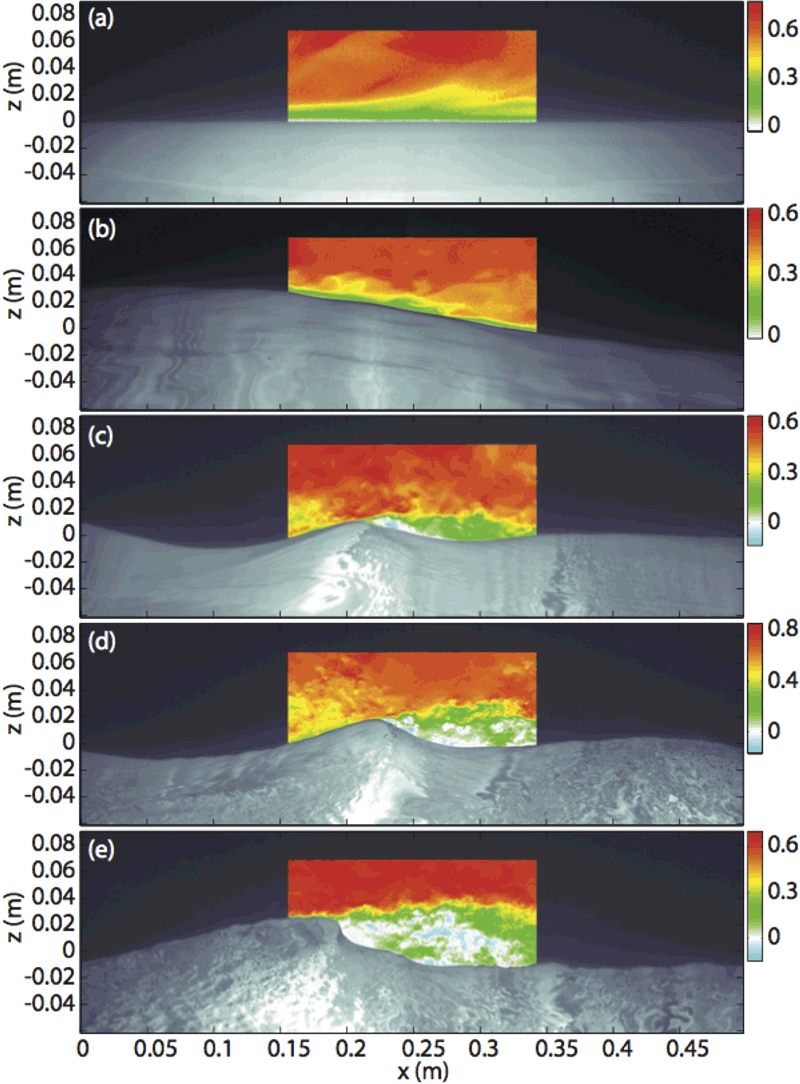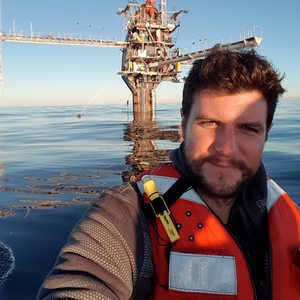M6: Techniques for atmosphere-ocean wave coupling
Principal investigators: Prof. Michael Hinze (Universität Hamburg), Dr. Jeff Carpenter (Helmholtz Center Geesthacht)
Objectives

We propose to develop new techniques to examine the energy pathways between the atmosphere and ocean due to the dynamics of wind-generated ocean surface waves. This is done primarily through the development of a numerical process model to describe the physical effects at the sharp density interface between atmosphere and ocean, as well as a novel field campaign designed to measure the near-surface ocean energy budget. The connection between these two different methods of analysing the surface wave energy processes will be developed primarily in the future stages of the research proposal. However, a comparison and validation of the numerical model is planned through the analysis and simulation of collected laboratory data using the field methods. Therefore, the primary goal of this subproject is to build up the infrastructure for new process modelling of atmosphere-ocean coupling that is required for the next phase of the CRC.
The numerical modelling will be developed with the help of diffuse interface approaches for multiphase flows with variable densities. Using a variable-density model results in a system of the Cahn-Hilliard/Navier-Stokes type that has already been used to successfully simulate idealised bubble dynamics. We tackle this mathematical model numerically with fully adaptive and integrated numerical schemes tailored to the simulation of variable density multiphase flows governed by diffuse interface models. Our approach is based on a fully adaptive, integrated, efficient, and reliable, numerical method for the simulation of two-dimensional multiphase flows with variable densities. Here, fully adaptive, integrated, efficient, and reliable means that the mesh resolution is chosen by the numerical algorithm according to a prescribed error tolerance in the a posteriori error control on the basis of residual-based error indicators, which allow to estimate the true error from below (efficient) and from above (reliable). The diffuse interface method provides a thermodynamically consistent treatment of the air-water interface that will be extended to model the growth and evolution of wind-generated water waves, and in the next phase of the CRC, atmosphere-ocean interaction. To the best of the applicants knowledge this study would be the first to develop a diffuse interface model to be used in the study of atmosphere-ocean interactions. This shall be done by extending our approach to the simulation of three-dimensional flows, where we incorporate the simulation of surface waves via appropriate forcing terms and boundary conditions. We envision that the development of such a model will allow for detailed process modelling that permits a new understanding and parameterisation of atmosphere-ocean energy transfers.
Parallel with the development of such a model, we propose to conduct a field study to quantify the near-surface energy budget. This would be done by extending an already funded project being carried out at the Helmholtz Zentrum Geesthacht (HZG) designed to measure wind energy input to surface waves. Through this already planned field work, the particle imaging velocimetry (PIV) and laser induced fluorescence (LIF) techniques will be used in situ. As a part of the present CRC project, we shall extend the existing field work to measure the dissipation of energy in the surface wave field and upper ocean mixed layer. This will be done by providing direct microstructure-based and PIV-based measurements of upper ocean turbulence dissipation, as well as through optical techniques of measuring whitecap coverage and wave breaking statistics. This experiment will be the first to combine both energy input and dissipation estimates using these techniques to the surface wave field, and can be used to construct a near-surface ocean energy budget.
Problem
- Transfer of energy from wind to ocean waves represents the largest in the ocean
- Major difficulties exist in measuring and modelling this energy transfer
- These difficulties have hindered the understanding of processes and the accurate modelling and parameterisation of the wind-to-wave energy transfer
Methods
- Measurements from a pole mounted in Baltic Sea, and from moored platform FLIP
- Modelling using a diffuse-interface approach for the coupled simulation of atmosphere and ocean
Results
- First 2D airflow fields over open ocean waves have been measured using two platforms (FLIP, Oderhaf Pole)
- Have developed a method to reconstruct mean pressure from PIV data
- The method is able to close the momentum budget to within 10%
- Can compute energy transfers from wind to wave
- Transferred existing theoretical concepts from two to three dimensions
- Extended variational multiscale methods to the case of two-phase flows, needed for computations with realistic parameter values
- Implemented the framework into the FresCO+ environment, allowing for the simulation of threedimensional turbulent flows at the atmosphere-ocean interface
Outlook
- Use techniques developed in the 1st phase (i.e., in-situ PIV, pressure reconstruction, phase field turbulence modelling) to examine wind-to-wave energy transfer and wave breaking mechanisms
- Extend PIV to near-surface water layer simultaneous with air layer and quantify energy fluxes and dissipation to complete budget
- Incorporate surface waves into global circulation models in an energetically consistent framework
Invited Guests
Reports
Novel Measurements for Surface Waves
I recently developed a system to measure both ocean wave dynamics and turbulent motions in the airflow above the waves.
I’m Marc Buckley, a Postdoc in the Techniques subproject. My objective to measure and understand small-scale physics within the first few meters above and below the wavy ocean surface, and how they influence fluxes of energy between the atmosphere and the ocean. My main experimental approach is Particle Image Velocimetry (PIV), which consists in seeding a turbulent flow with particles and tracking the particles to retrieve information about the turbulent motions in the flow. I recently developed such a system to measure both ocean wave dynamics and turbulent motions in the airflow above the waves. I deployed it first from R/P FLIP in October 2017 off the coast of California, and more recently (September-October 2018) from a small platform in the Oder Lagoon (Baltic Sea lagoon).
We plan to use these novel measurements alongside laboratory wave tank measurements to test and validate a wind-wave coupling model developed at University of Hamburg by Michael Hinze and Nicolas Scharmacher. Additionally, we plan to use these high resolution measurements to better understand the complex physical processes that control air-sea energy fluxes, including airflow separation past steep surface waves, wave breaking, wave and current generation through the action of viscous and form (pressure) stresses. This will possibly lead to a novel physics-based air-sea energy and momentum flux parameterization, that may go beyond existing bulk parametrizations that are used in current atmospheric and oceanic models.
The making and breaking of waves
My job will be the numerical analysis and implementation of the Cahn-Hilliard/Navier-Stokes model.
Hey, my name is Nicolas and I'm a PhD student currently working on the subproject M6: Techniques for atmosphere-ocean wave coupling, together with my supervisor Prof. Dr. Michael Hinze and also Dr. Jeff Carpenter and Dr. Marc Buckley from the HZG.
The energy transfer from the wind to the ocean surface and the energy dissipation caused by breaking waves accounts for the largest transfer of energy from the atmosphere to the ocean. However, despite the importance of the processes involved in surface wave generation and breaking, there are still fundamental gaps when it comes to modeling these processes.
We hope that the diffuse interface methods developed for the Cahn-Hilliard/Navier-Stokes model we are using will provide an improved method to deal with the current shortcomings of the simulation of the air-water interface. We believe that the method is well suited for that purpose due to its thermodynamical consistency, its mass-conserving property and its ability to handle topological changes, which might occur in breaking waves.
My job will be the numerical analysis and implementation of the model in order to be able to provide direct numerical simulations of the airwater interface in three dimensions, with focus on the formation and breaking of wind-generated surface waves. This requires, for example, the development and implementation of energystable time-integration schemes, efficient solvers and appropriate ways to incorporate the windforcing. Once finished, we will compare our simulations with measurements from laboratory experiments our colleagues at HZG have conducted.
Publications
Merckelbach, L.M. & Carpenter, J.R. (2021). Ocean Glider Flight in the Presence of Surface Waves. J. Atmos. Ocean Tech., 38(7), 1265-1275, doi: 10.1175/JTECH-D-20-0206.1.
Yousefi, K., Veron, F., & Buckley, M.P. (2020). Momentum flux measurements in the airflow over wind-generated surface waves. J. Fluid Mech. 73, doi: https://doi.org/10.1016/j.euromechflu.2018.04.00.
Savelyev, I. B., Buckley, M. P., & Haus, B. K. (2020). The impact of nonbreaking waves on wind‐driven ocean surface turbulence. J. Geophys. Res.: Oceans, https://doi.org/10.1029/2019JC015573.
Husain, N. T., Hara, T., Buckley, M. P., Yousefi, K., Veron, F., & Sullivan, P. P. (2019). Boundary layer turbulence over surface waves in a strongly forced condition: Les and observation. J. Phys. Oceanogr., 49(8), 1997-2015, doi: https://doi.org/10.1029/2019JC015156.
Merckelbach, L., A. Berger, G. Krahmann, M. Dengler and J. R. Carpenter (2019). A dynamic flight model for Slocum gliders and implications for turbulence microstructure measurements. J. Atmos. Ocean. Tech., Vol. 36 (2), 281-296, doi: https://doi.org/10.1175/JTECH-D-18-0168.1.
Garcke, H., Hinze, M., & Kahle, C. (2019). Diffuse Interface Approaches in Atmosphere and Ocean—Modeling and Numerical Implementation. In Energy Transfers in Atmosphere and Ocean (pp. 287-307). Springer, Cham., doi: https://doi.org/10.1007/978-3-030-05704-6_9.
Carpenter, J. R., Guha, A. & Heifetz, E. (2017). A physical interpretation of the wind-wave instability as interacting waves. J. Phys. Oceanogr., doi:
